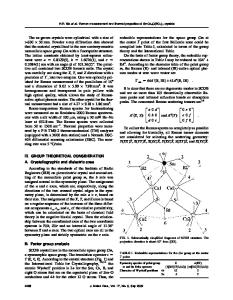Growth, defects, and properties of GdCa 4 O(BO 3 ) 3 and Nd:GdCa 4 O(BO 3 ) 3 crystals
- PDF / 194,584 Bytes
- 7 Pages / 612 x 792 pts (letter) Page_size
- 78 Downloads / 395 Views
Yulian Tian, Jianhua Jiang, and Wanxia Huang Beijing Synchrotron Radiation Laboratory, Institute of High Energy Physics, Beijing 100039, People’s Republic of China (Received 2 March 2000; accepted 29 December 2000)
Pure and neodymium-doped gadolinium calcium oxoborate crystals of high quality were grown by the Czochralski method. The orientation of crystal was precisely determined, and the samples for measurements were prepared. Through synchrotron x-ray topography and high-resolution x-ray diffractometry, the twin structure was discovered. Some properties such as the figure of merit value, and dielectric, piezoelectric, and elastic constants were measured along with a discussion of the anisotropy of the laser properties.
I. INTRODUCTION
II. CRYSTAL GROWTH
When a crystal possesses both laser and nonlinear optical (NLO) properties, we call it a self-frequency doubling (SFD) crystal. A SFD crystal combines different functions of laser emission and frequency conversion, providing a simple approach to coherent visible radiation. Among the various SFD crystals, neodymiumdoped yttrium aluminum borate (NYAB) was recognized as a promising candidate for practical applications.1,2 However, the inhomogeneity of the crystal originating from the structural difference of the two component crystals NAB (monoclinic) and YAB (trigonal) have hindered its commercialization.3,4 Gadolinium calcium oxoborate [GdCa 4 O(BO 3 ) 3 , GdCOB] and its analogue, crystal yttrium calcium oxoborate [YCa4O(BO3)3, YCOB], are newly developed nonhygroscopic NLO crystals with a large transparency range, reasonable NLO coefficients, and high damage thresholds.5,6 The structural analysis of these two crystals7,8 indicates that they belong to monoclinic space group Cm. The Gd ions in GdCOB and Y ions in YCOB crystals can easily be replaced by active laser ions, such as Nd or Yb, to form SFD crystals, and the experimental results have shown that they are promising SFD crystals.9–13 We grew optical–quality GdCOB and Nd:GdCOB crystals. Using synchrotron x-ray topography and highresolution x-ray diffractometry, we investigated the perfection of these crystals. Their various physical properties, such as electric and elastic constants, were measured. The laser properties were also investigated.
GdCOB and Nd:GdCOB crystals were grown by the Czochralski method. A 2 kHz radio frequency furnace and a noble metal crucible were used. The raw materials were 4N Gd2O3 (Nd2O3), CaCO3, and B2O3. They were weighed according to the stoichiometric ratio of the desired composition. Considering the evaporation of B2O3 during the growth process, we sometimes added an excess of B2O3 (less than 2%) to the starting components. All the chemicals were ground and mixed thoroughly. Then the mixture was pressed into pillar pieces and heated to 1200 °C for 12 h in a platinum crucible with a resistant tube furnace. X-ray powder diffraction showed that polycrystalline GdCOB was formed by solid-state reaction. The polycrystalline material was then moved to an iridium crucible in the radi
Data Loading...










